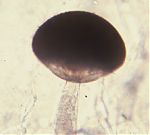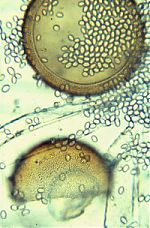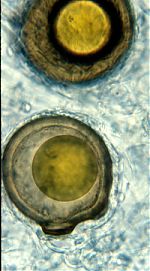Pilaira
PILAIRA van Tieghem, 1875 (Ann. Sci. Nat. Bot., Sér. 6, 1:51); 5 spp. (Grove, 1934—ILLUS. and KEY TO SPP.; Mil’ko, 1970—illus.).
Species of Pilaira produce simple or branched sporangiophores that bear cutinized, apophysate sporangia apically. The entire sporangial wall detaches along a basal suture when the structure comes in contact with a solid object. Zygospores, where known, are formed on apophystate, entwined suspensors in the substrate. The zygosporangial wall is covered with undulate ornamentation and it is hyaline, whereas the zygospore is pigmented. A trophocyst is not produced.
Type species: P. anomala
Species of Pilaira:
P. anomala (Cesati) Schröter, 1889 [in Cohn’s Kryptogamen-Flora von Schlesien. III (I). Pilze, p. 211].
P. caucasica Mil’ko, 1970 (Mikol. i Fitopatol. 4:263).
P. dimidiata Grove, 1884 (J. Bot. 22:132).
P. moreauii L. Yong, 1926 ( Étude Morphologique, cytologique et microchimique d’une nouvelle Mucorinée, Pilairia moreauii, p. 4 [Latin diagnosis also in Yong, 1930, p. 742]).
P. nigrescens van Tieghem, 1875 (Ann. Sci. Nat., Bot., Sér. VI, 1:60).
Five species are recognized by Mi’ko (1974); three of these species are in culture: P. anomala, P. caucasica, and P. moreauii. Pilaira anomala is the only species that is ordinarily isolated in nature. Pilaira is usually isolated from dung. Ontogeny of the anamorph and teleomorph of P. anomala have been illustrated by Benny and O’Donnell (1978).
Bibliography
Benny, G.L., and K.L. O’Donnell. 1978. Pilaira anomala, pp. 129-130. In: M.S. Fuller (ed.). Lower fungi in the laboratory. Palfrey Contributions in Botany. No. 1. Department of Botany, University of Georgia, Athens, Georgia.
Grove, W. B. 1934. A systematic account and arrangement of the Pilobolidae., pp. 190-224, In A. H. R. Buller. Researches on Fungi. Vol. 6. London, Longmans Green and Co. 513 p.
Mil’ko, A.A. 1970. Pilaira caucasica Milko and related species. Mikol. i Fitopatol. 4:262-264.
Updated Mar 13, 2005



